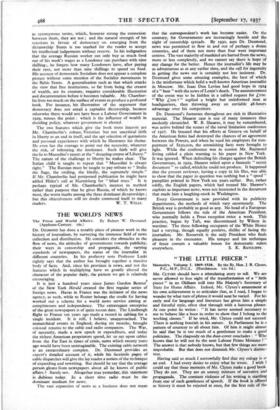THE WORLD'S NEWS
The Press and World Affairs. By Robert W. Desmond. (Appleton-Century. 16s.)
DR. DESMOND has done a notable piece of pioneer work in the history of journalism, by surveying the immense field of news collection and distribution. He considers the obstacles to the flow of news, the attitudes of governments towards publicity, their ways in censorship and propaganda, the varying standards of newspapers, the status of the journalist in different countries. In his prefatory note Professor Laski rightly says that the author has brought together a massive body of facts. And, since his province is news, and not the features which in multiplying have so greatly altered the character of the popular daily, the picture we get is relatively encouraging. It is just a hundred years since James Gordon Bennett of the New York Herald created the first regular series of foreign news. Havas in France was the initiator of the news agency, as such, while to Reuter belongs the credit for having worked out a scheme for a world news service aiming at completeness and independence. The extravagant enterprise of the great newspapers is of quite recent date_ The Lindbergh flight to France ten years ago made a record in cabling for a single incident. It is still, I believe, unapproached. The monarchical events in England, during six months, brought colossal returns to the cable and radio companies. The War, of necessity, made a new epoch in expenditure, and today the richest American proprietors spend, let us say upon cables from the Far East in times of crisis, sums which twenty years ago would have been unimaginable. The existing cable network is an extraordinary complex. Dr. Desmond provides an expert's detailed account of it, while his facsimile pages of cable dispatches will give the lay reader a notion of the technique of expanding and rewriting. But should he say that the average person gleans from newspapers about all he knows of public affairs ? Surely not. Altogether true yesterday, this statement is dubious today. In a short time radio must be the dominant medium for news.
The vast expansion of news as a business does not mean
that the correspondent's work has become racier. On the contrary, for Governments are increasingly hostile and the night of censorship spreads. By 1930, says Dr. Desmond, news was permitted to flow in and out of perhaps a dozen countries, and of these not more than four were important centres. The vast majority of mankind are barred from the news, more or less completely, and we cannot say there is hope of any change for the better. Hence the journalist's life may be as adventurous as at any earlier time, and the call for ingenuity in getting the news out is certainly not less insistent. Dr. Desmond gives some amusing examples, the best of which is the misfortune which befel a well-known American journalist in Moscow. Mr. Isaac Don Levine had good hope in 1924 of a " beat " with the news of Lenin's death. The announcement of the event was to be hidden in a cabled request for Lioo. " Why £ioo ? " replied a bright but uninformed man at headquarters, thus throwing away an enviable 48-hours advantage over his competitors.
Dr. Desmond's footnotes throughout are rich in illustrative material. The Shearer case is one of many instances thus modestly chronicled. W. B. Shearer, it may be remembered, was active behind the scenes of the naval limitation conference of 1927. He boasted that his efforts at Geneva on behalf of the American firms had destroyed the chances of an agreement between the Powers, and when he sued his employers for non- payment of $25o,00o, the astonishing facts were brought to light. While the conference was in session Mr. Raymond Swing cabled a plain warning to his paper in New York. It was ignored. When defending his charges against the British Government, in 1929, Shearer relied upon a fantastic " secret document " so called, which he could not produce. It happened that the present reviewer, having a copy in his files, was able to show that the paper in question was nothing but a " spoof " pamphlet printed in New York ten years earlier. But, rather oddly, the English papers, which had treated Mr. Shearer's exploits as important news, were not interested in the document that made him a laughing-stock in Washington.
Every Government is now provided with its publicity departments, the methods of which vary enormously. The British way is probably as good as any. No head of a European Government follows the rule of the American President, who normally holds a Press reception twice a week. This practice, begun by Taft, was discontinued by Wilson in wartime. The three following occupants of the White House had a varying, though equally positive, dislike of facing the journalists. Mr. Roosevelt is the only President who finds -pleasure in the encounter. His temper and his technique of fence contain a valuable lesson for democratic rulers










































 Previous page
Previous page